Are you looking for a character sketch template that will make your character building easier and more fun?
Scrivener has an amazing character sketch tool that you can use to develop better characters.
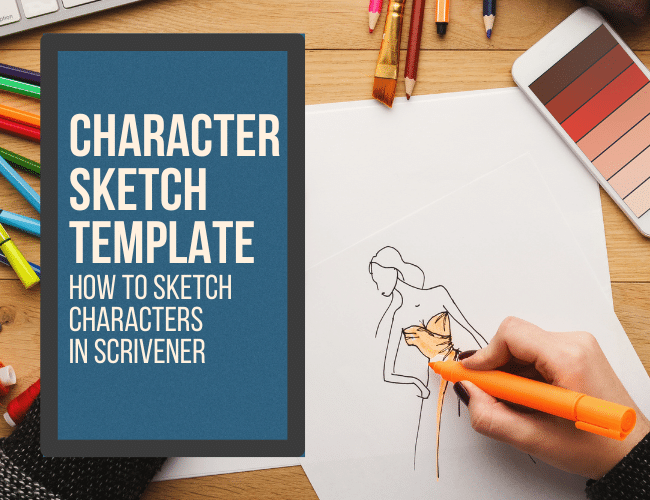
In this article, you'll learn how to sketch a fictional character and cast that will make you proud. Read on for a hands-on walkthrough of how to use Scrivener to create characters, from character profiles to their physical descriptions, and then some.
Characters Can Make Your Book. Here's How to Create Them
Nothing is born in a vacuum. Characters don’t emerge fully formed. Character development is a process of getting to know your characters and working to make them come to life. They’re developed through character sketches, through the writing process itself, through lots feedback, and diligent revision.
When you're going through the character development process, it's helpful to have some tools at your disposal, and one of the most helpful tools for writers, especially when it comes to working on your characters, is Scrivener.
What is a character sketch, what is Scrivener, and how can it help you create compelling characters? Read on to learn more!
Full disclosure: some of the links to Scrivener below are affiliate links. That means if you order Scrivener and use it to write your books, I will earn a few dollars to help me keep writing. That being said, this didn't affect my opinion of Scrivener (which I personally use in my own writing).
What is Scrivener?
Scrivener is a writing program and word processor designed specifically by writers, for writers. If you're working on a book, I've found that Microsoft Word and other word processors just don't cut it.
Having a tool like Scrivener that's designed specifically for books can save you hundreds of hours and help you write a better book.
If you're interested in learning more about Scrivener, read our Scrivener review here.
What Is a Character Sketch?
Think of a character sketch as the rough draft of your character. It’s a place where you can freely experiment, where you can tell yourself (or your writing partner) who your characters are, how they look, and where they come from.
You can type out their whole backstory, or just the parts of the timeline that inform your character’s identity. Their inner and external conflicts will be crucial to your story, so be sure to include those, too.
Most importantly, use character sketches as a tool to discover your characters’ key motivations and goals, because those are the engine that drives your story forward.
How to Use Template Sheets in Scrivener

Scrivener has a template sheets function that makes building out character sketches easy. If you started using one of their document templates, like the novel template that comes with Scrivener, there should already be a Template Sheets folder in the project document that looks like the screenshot to the right.
If not, you can make a Template Sheets folder by creating a new folder in the Binder (the lefthand column), and then from the top menu selecting Project > Set Selection as Templates Folder.
Once you have the folder, you can add as many templates as you like!
One more note before we get started: I reference Scrivener’s features and include screenshots of the software, but you can still use these methods without Scrivener. Simply create a separate text file for each character and keep them in a folder named “My Story—Character Sketches.” If you're interested in Scrivener, Joe reviewed it here.
Visualize Your Characters Using Scrivener’s Corkboard
Now that you have your template sheets folder, you can generate character sketches by creating new files from the template sheets you have.
Fortunately, we live in a digital age and Scrivener’s digital corkboard interface gives us the power of notecards in a way that allows us to drill down from the card view into the character sketch itself.
The notecard system is well documented and has been made famous by a dead author, a living author, Writer’s Digest, and teenagers writing research papers everywhere. Scrivener simply digitizes this time-tested method.
In the screenshot below, you’ll see that I have several characters in view. They’ve all been generated from the Character Sketch template sheet we created previously.
What’s great about this is that you have a card for each character, with optional visuals or text description.
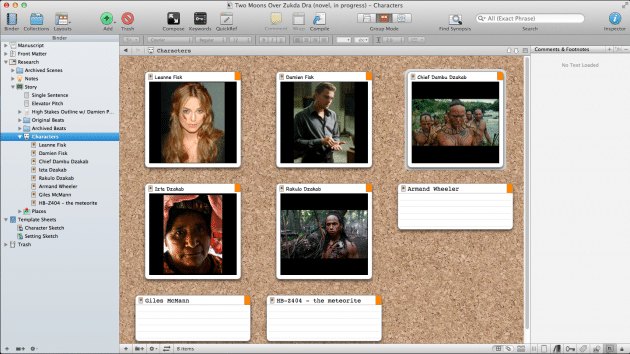
I go for visuals out of the gate, as it helps me ground my character in an image. Having a visual on hand makes writing about them easier, at first, because the photos jog my imagination. Once I’m really entrenched and know my characters (i.e. about twenty-five percent of the way through the first draft), I don’t need to look at the visuals at all.
You'll notice that some characters don't have photos—I added those characters during the story and didn't bother going back to find photos for them.
That’s okay. One of the most important things to remember about your planning or pre-production phase (to borrow a film term), including character sketches, is that none of it is set in stone.
Your story will evolve, and so will your characters.
For the images I’ve picked a few actors and photos I found on Google Images.
To add a photo to a Character Sketch in Scrivener, click on the character’s card, open the Notes column on the righthand side, and drag your image into the image area where the instructions are:
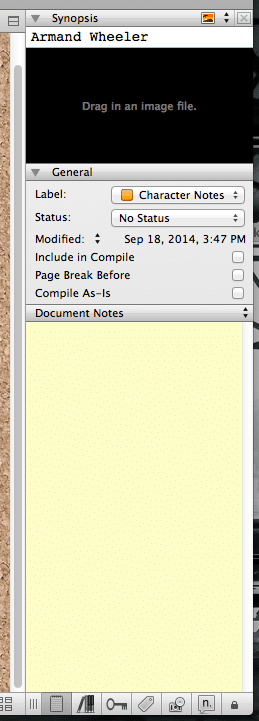
To insert a photo inline with the text, first click where you want the photo, and then go to Edit > Insert > Image from File…
Individual Character Sketches
Here’s a screenshot of an individual sketch of one of my characters:
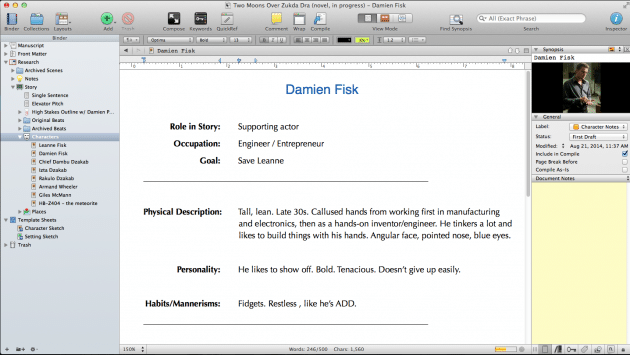
This sketch was created using the character sketch template that comes with Scrivener. I’ve since abandoned Scrivener’s defaults in favor of my own compilation, which follows.
An Alternative Character Sketch Template
As you learn more about character sketches, you'll probably want to customize your character sketch template and make it your own.
Personally, I find Scrivener's default sketch sheets superficial. When sketching characters, I like less structure, and less prescriptive fields around the character's physical appearance and personality.
If you're just starting out and you don’t have a character sketch template, here’s one I put together based on my own experimentation.
This is what my character sketch template looks like in Scrivener:
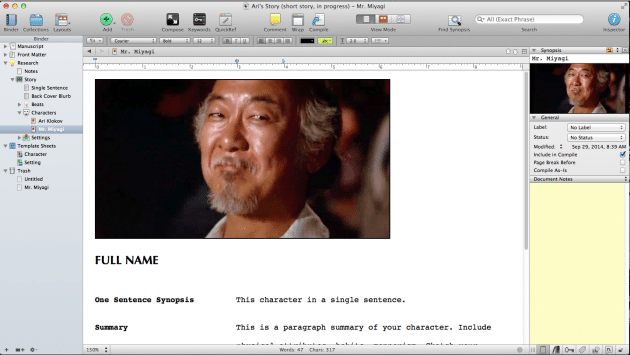
And here's the full text, which you can feel free to use or modify as you see fit:
Character Sketch Template
[photo]
CHARACTER'S FULL NAME
One Sentence Synopsis: This character in a single sentence.
Summary: This is a paragraph summary of your character. Include physical attributes, habits, mannerism. Sketch your character.
Motivations & Goals: What do they want?
Conflicts: What makes them human?
Narrative: What happens to them in the story? What else is important?
Why Character Sketches Work
There are practical reasons to do character sketches. For one, developing characters is a process. Paving the way with character sketches and setting sketches, are a great way to give the gel of the story time and space to set.
Yes, they're extra work, and yes they can be difficult. But that's part of the process.
If you feel like you really know the character and can write the story, run through this checklist to make sure before you move on:
- What is your character’s primary motivation? What are their hopes and dreams?
- How does your character change in the course of the story?
- What does your character look like? How do they act around their parents? Their friends? Their boss?
- How does your character act under stress?
- What is your character’s weakness, their kryptonite?
- What will your character die for?
- What is your character’s biggest hypocrisy?
If you can answer all of these questions with confidence, congratulations, you know your cast and can throw them together in your story to see how they respond.
Ready to Develop Your Characters With Scrivener?
Now that you've learned how to do character development in Scrivener, put it to use!
You can get the Mac, PC, and iOS version and start creating your character sketches in Scrivener now:
Download Scrivener here »
Or if you're still wondering if Scrivener can help you finish your books, read our Scrivener review here.
Then, continue to the practice section for a writing exercise to help you get started.
Does your method for sketching characters line up with how I do things? What are your tricks for helping bring your characters to life? Share in the comments section.
PRACTICE
Here's a creative writing prompt to help you get started with character sketches.
Take fifteen minutes to sketch one character. If you have a work in progress, choose a character from that story. Or, pick one of the characters below:
- A disciplined, medal-winning Jui Jitsu practitioner whose sister just died
- A mother of three on a Thursday morning
- A soldier who has returned home after being a prisoner of war in Iraq
- A journalist covering the derailing of a local train that killed four passengers
Naming them is just the beginning. Don’t be afraid to get personal with the characters you create. When you're finished, share a few paragraphs about your character in the practice box below. Then, be sure to leave feedback for three of your fellow writers on their characters. We'd love to see who you come up with!
Happy writing!
Matt Herron is the author of Scrivener Superpowers: How to Use Cutting-Edge Software to Energize Your Creative Writing Practice. He has a degree in English Literature, a dog named Elsa, and an adrenaline addiction sated by rock climbing and travel. The best way to get in touch with him is on Twitter @mgherron.



Great article. I’ve been using scrivener for a while but character sketch always seemed vague. I only just found out the attach an image function a few weeks ago. That’s for providing some great advice.
Cheers, Michael! I’m glad you found it useful
I can’t say enough about how much I love, love, love Scrivener!!!
Me too, Dawn. Thanks!
Thanks for the wonderful article! You have inspired me to clean up my character sketches to look as aesthetically pleasing as that. I didn’t know you can put their photo within the same written document in such a neat way. I usually attach a character sketch under the character photo as two seperate documents and then use the split screen to write their profile while drawing inspiration from the accompanying photo.
You also have great points to consider for character traits and would be honoured if you and other readers of this post can also check out my blog series on Crafting a Character @ http://yourwritetolive.com/blog-series/
Hi Matt, to get my characters leap off the page, I look at their conflict and try to create conflicting interests between all characters, not just protagonist-antagonist. It layers the story, gives it edge and entertains the most. One very useful trick is to limit your characters’s trait to four major traits, one being totally opposite, out of the box trait, if possible and run your character’s dialogue through them, – one character at a time, all dialogues throughout the story, eye on traits. Leaping off page guaranteed. :0)
https://www.facebook.com/natalie.melvin.10
yeah that’s a good idea! there needs to be a world outside of the protagonist that’s alive and breathing. That does make it more realistic.
thanks for the tip Natalie, that’s awesome. I like to delve into the conflicting interests of my characters in the “Narrative” part of the sketch I put in the article, but that’s a good point that people often forget to consider minor characters.
Thanks for the lesson, Matt. I’m definitely going to keep your post to refer back to again. I bought Scrivener this spring and tried to apply to my novel that was already complete. It was too confusing, but I’m anxious to use if for my next book. Thanks.
A friend of mine and I designed a character questionnaire that I filled out for my main character. If you want to use it feel free. I left a couple questions blank because I haven’t gotten there yet with planning; also, you’re supposed to answer the questions in first person but that was a little too weird for me so I stuck with third.
CharacterChart
Fill out these questions as if you were your character.
The Basics:
Name: Alexandra “Alex” MacBride
Age: 14
Gender: Female
Birthday:
Hair color: pale red
Eye color: blue
Ethnicity: Caucasian, American
Height: 5’5”
Weight: 138 lbs.
Distinguishing features: freckles
Questions:
1. Introvert or extrovert?
Introvert
2. Who do you live with?
Mother, father and cat
3. Where do you live?
Oak Ridge, NJ
4. Describe your social group in a few words:
Uninteresting, shallow, followers (leaves this social group in the beginning of the story)
5. Risk taker or not?
Initially no, but lets this side of her emerge as the story progresses
6. Hobbies and interests?
Reading, writing, playing with her cat, riding her bike, thinking too much, listening to music and audiobooks
7. Music taste?
Alternative rock
8. How do you dress?
Jeans and t-shirts kind of girl
9. Sexual/gender orientation?
Cisgender female, heterosexual
10. Favorites (color, food, book, movie, song, article of clothing, etc.)
Color: blue, Food: pizza, Book: The Last Camel Died at Noon by Elizabeth Peters, Song: Leave Out All the Rest by Linkin Park, Article of Clothing: purple fleece-lined sweatshirt, Shoes: green Chuck Taylor high tops
11. Any material items that mean a lot to you?
A fuzzy blanket she’s had since childhood. She plays with the fibers while she falls asleep and it helps her relax.
12. Favorite childhood memory? Least favorite?
Favorite: her father reading her bedtime stories
Least favorite: getting picked on a few times in elementary school for being bookish
13. Mental/physical disorders?
None
14. Fears?
Not being good enough, getting in trouble (this particular fear diminishes as the story progresses)
15. Favorite/least favorite people?
Least: Her erstwhile “friends”
Favorite: Alicia Cameron (her new best friend by the end of the story)
16. Jobs (or dream job)?
Author
17. What is/was favorite subject in school?
English
18. Did you go to/plan on going to college?
Plans on going
19. What makes you angry?
Other people being treated unfairly especially people she cares about, injustice in general, being talked down to, not living up to her own standards
20. What makes you sad?
Failing herself or someone important to her
21. What makes you happy?
Accomplishing a goal, spending time with people who care about her, writing (when it’s going well), reading, dancing to music in her room
22. Goals?
Completing a big writing project, surrounding herself with people who love her that she loves too, figuring out what she wants to do in life
23. Biggest regret?
All the times she didn’t stand up for herself or someone else when she should’ve, not accomplishing goals she set for herself because of laziness
24. What are you most proud of?
25. Character flaws?
Laziness, low self esteem, a bad temper
26.Transportation of choice?
Bike
27. What’s your love life like?
Non-existent
28.Pet peeves?
29.Favorite type of weather?
Rainy
30. Favorite/least favorite of your physical characteristics?
Favorite: hair
Least favorite: freckles
31. Religious/political beliefs?
Raised Catholic, personally agnostic
32. Do you play any instruments?
No
Weird Questions:
1. If you saw a dog drowning in a pond and you were late to school/work, would you
save it? Why/why not?
Yes, because she hates to see anything helpless being harmed
2. If you were stranded on a desert island and could have one other person and
three items with you, what would they be? Why?
Person: Alicia
Items: computer to write on, the fuzzy blanket from her bed for comfort, and The Last Camel Died at Noon to read
3. You’re at a party. What are you doing? What decisions are you making?
At party, she’d be standing in the corner not speaking unless spoken to and observing the actions of the other people around her.
4. It’s three in the morning and you’re up with friends. What sort of things do you talk about? Are you less inhibited? Do you behave differently?
They’d talk about religion, philosophy, ethical questions, their goals and dreams, what they think of their families and classmates, etc. She’d not be less inhibited per say, but the more tired she gets the more she rambles.
5. If you could do three things with no negative consequences and no one knowing
you did it, what would you do?
1. Pull off an awesome prank
2. Bother all the mean people she doesn’t like
3. Take all the books she wants to read but can’t afford from the bookstore (although she’d probably feel so guilty she’d return them in secret after she’d read them)
These kind of exercises are the ones that I find too prescriptive. I prefer a much looser framework with more creative freedom when doing sketches. But hey, who am I to judge? Whatever works for you is what you should do!
Great points to use when building my next character sketches. I really need to get on board with scrivener
you won’t regret it! And if you have any trouble, get in touch with me, I’m happy to help!
I just got Scrivener a couple of months ago. I have a good idea of my protagonists, but I don’t think I’ve put as much effort into my antagonists. They’re just “the bad guys”; one of them wants revenge on my MC for putting him in jail and he’s recruited two others to help him.
I am loving these posts and the comments. Thanks so much, Matt. You are a treasure. I am really looking forward to working with Scrivener.